Many gardeners look for ways to make the most of their garden space, and growing squash vertically is one of the most effective methods.
This simple approach helps control vines, improves air circulation, and keeps the fruit clean and easy to pick. With the right setup and steady care, squash can grow even in limited areas.
Here you will find a clear, step-by-step look at how to grow squash vertically the easy way. The apt practical option for anyone aiming to boost harvests while keeping their garden neat and productive.
Benefits of Growing Squash Vertically
Vertical gardening changes everything for squash growers. Instead of watching vines sprawl across the yard, gardeners can train them upward.
- Maximizes Limited Space: Perfect for small gardens where ground area is precious. A single trellis can support multiple squash plants in just 2-3 feet of width, freeing up valuable garden beds for other crops.
- Better Airflow: Leaves dry faster after rain or watering, helping prevent powdery mildew and fungal problems that commonly plague ground-growing squash.
- Easier Fruit Inspection: Spot issues early and harvest at peak ripeness without having to search through tangled vines on the ground.
- Cleaner Produce: Squash stays off damp soil, reducing rot, decay, and slug damage significantly. Fruits develop evenly and have a better shape since they’re not resting on one side for weeks.
- Stronger Plants: Improved sunlight reaches all parts of the plant throughout the day, creating vigorous growth and higher yields.
These advantages show why vertical growing works so well for squash varieties of all types. The benefits extend from planting through the harvest season.
Best Squash Varieties for Vertical Growing
Not all squash varieties climb well. Some types naturally adapt to vertical supports, while others struggle with the weight of their fruits.
Choosing the right variety makes all the difference between success and disappointment.
1. Zucchini

Zucchini varieties like ‘Black Beauty’ and ‘Raven’ excel at vertical growing.
These summer squash produce compact fruits that won’t overburden supports. Vines grow vigorously but remain manageable with weekly training.
Harvest happens in just 50-60 days, and the upright position makes spotting ready fruits incredibly easy. Daily picking encourages continuous production throughout the summer.
2. Yellow Crookneck Squash
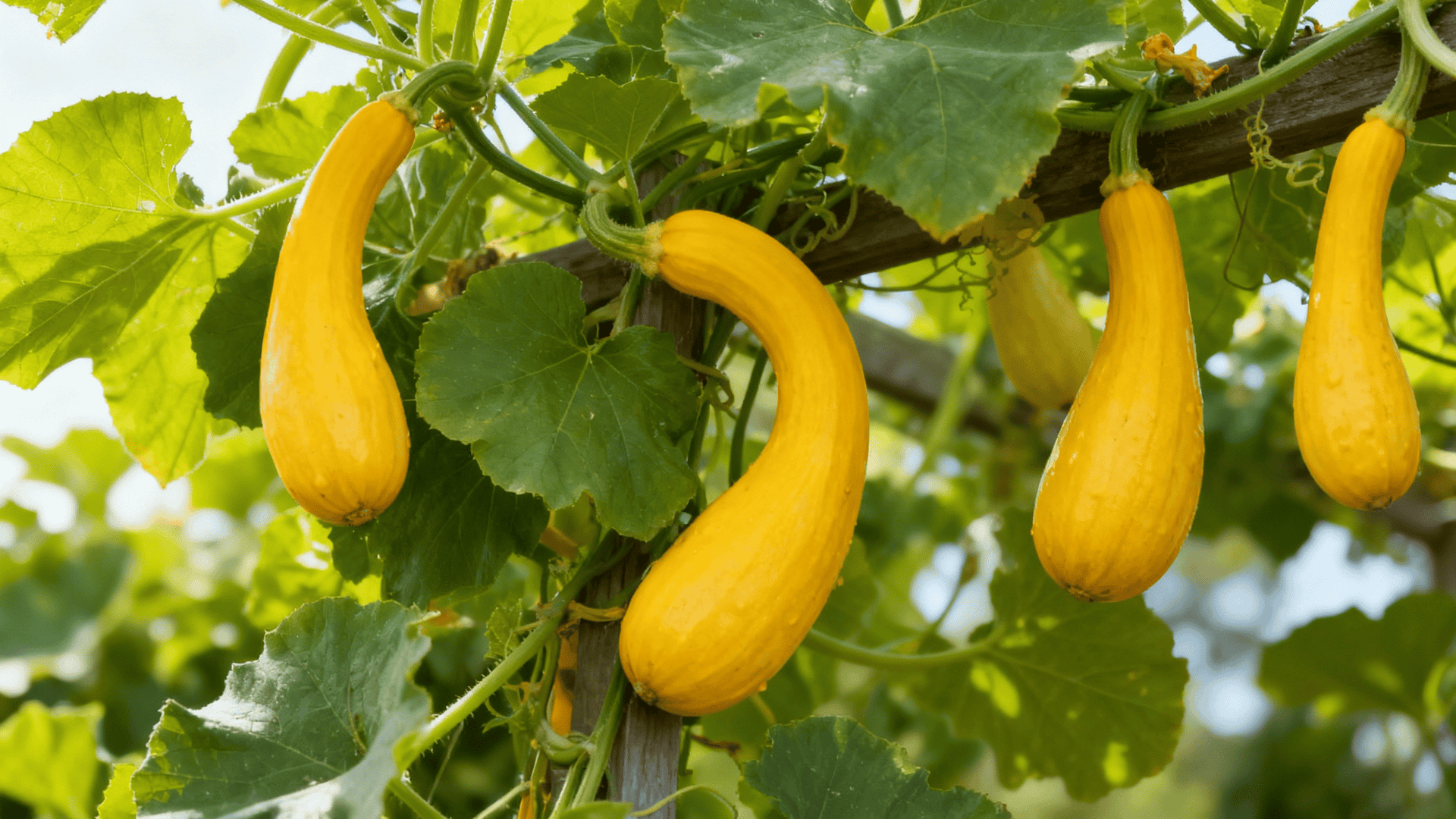
This classic summer variety adapts beautifully to trellis systems. The curved neck and moderate fruit size make Yellow Crookneck perfect for vertical gardening.
Vines climb naturally with minimal guidance, reaching 6-8 feet tall. Bright yellow fruits stand out against green foliage, signaling harvest time.
Plants mature in 55-60 days and produce steadily for months when picked regularly.
3. Butternut Squash

Butternut varieties like ‘Waltham’ work surprisingly well vertically despite their size. The key is providing sturdy support and using slings for developing fruits.
Vines grow 10-15 feet long, making vertical training essential in small spaces.
These winter squash need 85-100 days to mature, but the wait rewards gardeners with sweet, nutty-flavored harvests that store for months.
4. Delicata Squash

Delicata squash ranks among the best choices for growing squash vertically in compact gardens. Small, oblong fruits weigh just 1-2 pounds, requiring no extra fruit support. Cream-colored skin with green stripes makes identification simple.
Vines reach 8-10 feet but stay manageable. Harvest arrives in 80-100 days, delivering sweet flesh perfect for roasting. The thin skin is even edible.
5. Pattypan Squash
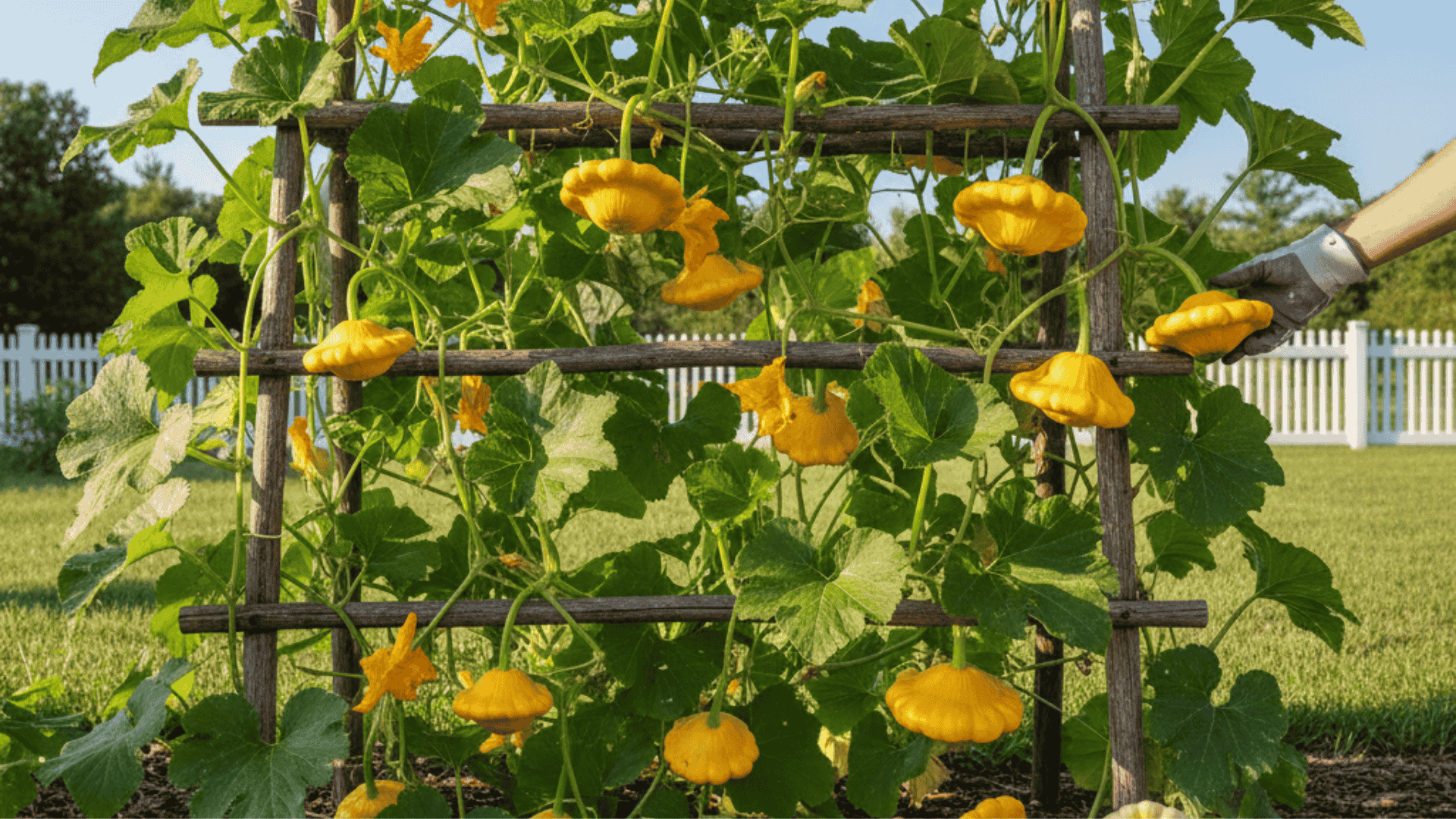
Pattypan varieties like ‘Gelber Englischer’ and ‘Sunburst’ bring unique scalloped shapes to vertical gardens. These saucer-shaped summer squash stay small and lightweight, rarely exceeding one pound.
The compact bush-to-vining habit adapts well to upright supports. Bright colors, yellow, green, or white, make harvest timing obvious.
Plants produce in 50-55 days, delivering tender, mild-flavored squash perfect for grilling or roasting.
6. Small Pumpkins
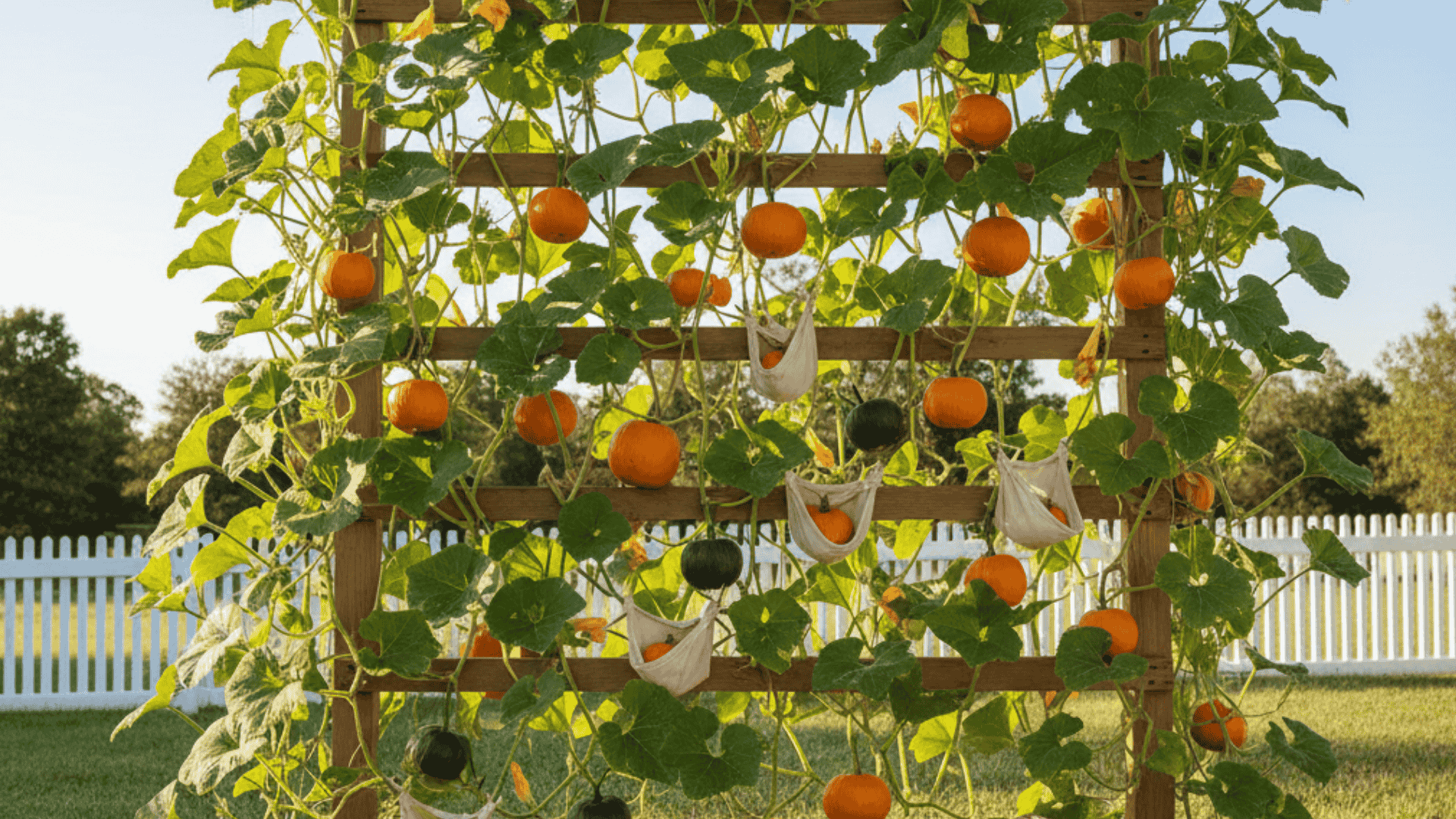
Miniature pumpkin varieties like ‘Jack Be Little’ and ‘Sugar Pie’ grow on vertical supports.
These petite pumpkins weigh just 8 ounces to 5 pounds, making them trellis-friendly. Vines climb 6-8 feet with moderate vigor and attractive foliage.
Fruit slings provide extra security as pumpkins develop their characteristic orange color. Maturity occurs in 90-100 days, making it perfect for fall decorating and pie-making.
7. Acorn Squash
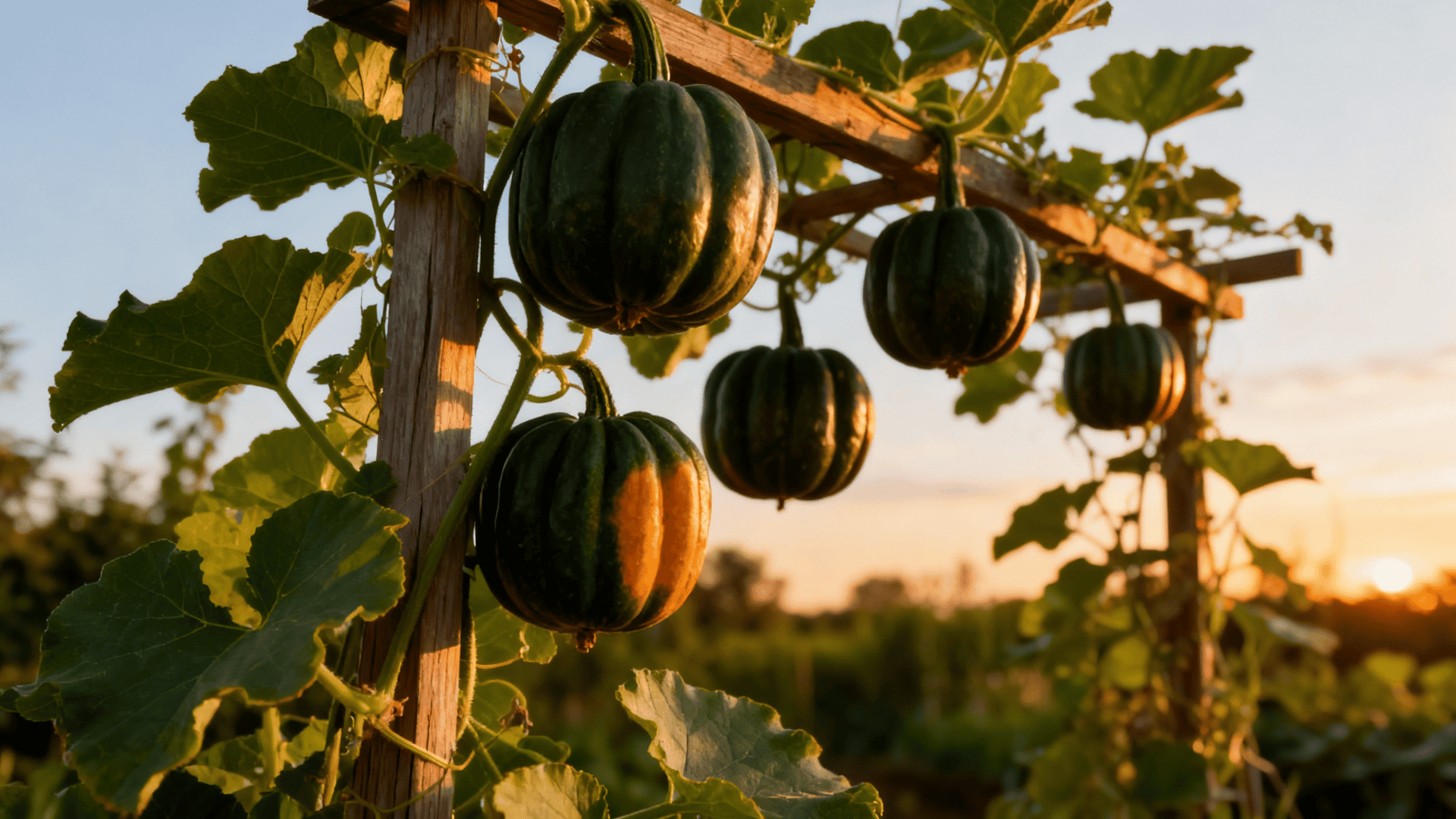
Acorn varieties adapt well to vertical structures when properly planned. Individual fruits are relatively small, weighing 1-3 pounds each. Dark green skin develops distinctive ridges as squash matures.
Strong trellis systems handle the weight easily. Plants need 75-90 days to reach full size.
The compact growth habit and moderate fruit production make acorn squash ideal for gardeners new to vertical methods.
Selecting appropriate varieties sets up vertical squash gardens for success. Each variety brings different flavors and growing characteristics that suit different garden goals and climates
Essential Tools and Materials for Growing Squash Vertically
Before starting, gather a few simple tools. These basics make growing squash vertically easier and keep your plants healthy and strong.
| Item | Use |
|---|---|
| Stake or trellis | Supports vertical growth |
| Shovel or trowel | For digging and planting |
| Compost or fertilizer | Feeds the plant |
| Mulch | Retains moisture, reduces weeds |
| Plant ties or paracord | Secures vines to support |
| Insect netting or clay spray | Protects from pests |
| Pruning shears | Removes damaged leaves |
| Q-tip or brush | For hand pollination |
How to Grow Squash Vertically: The Complete Process
Growing squash vertically is one of the best ways to get early, steady, and healthy harvests even in small spaces. With the right setup, care, and timing, anyone can keep their plants producing all season long.
Step 1: Prepare the Planting Area

Begin by choosing a sunny spot that receives at least six hours of direct light each day. Drive a strong stake about 5 to 6 feet tall firmly into the ground before planting to avoid damaging roots later.
Pull back any mulch until you reach the soil, then dig a hole deep enough for the young squash plant.
Mix a handful of homemade compost or garden soil blend with a scoop of all-purpose fertilizer, since squash are heavy feeders. Gently transplant your seedling next to the stake and press the soil around its base.
Step 2: Protect and Support Young Plants

About a week after planting, spray your plant with Surround Kaolin Clay or cover it with insect netting to guard against squash vine borers and cucumber beetles.
If using netting, remove it once flowers appear so bees can pollinate freely.
Keep an eye on your soil moisture and water deeply when the top inch feels dry. A steady start means stronger vines later.
Step 3: Train the Vines to Grow Upward
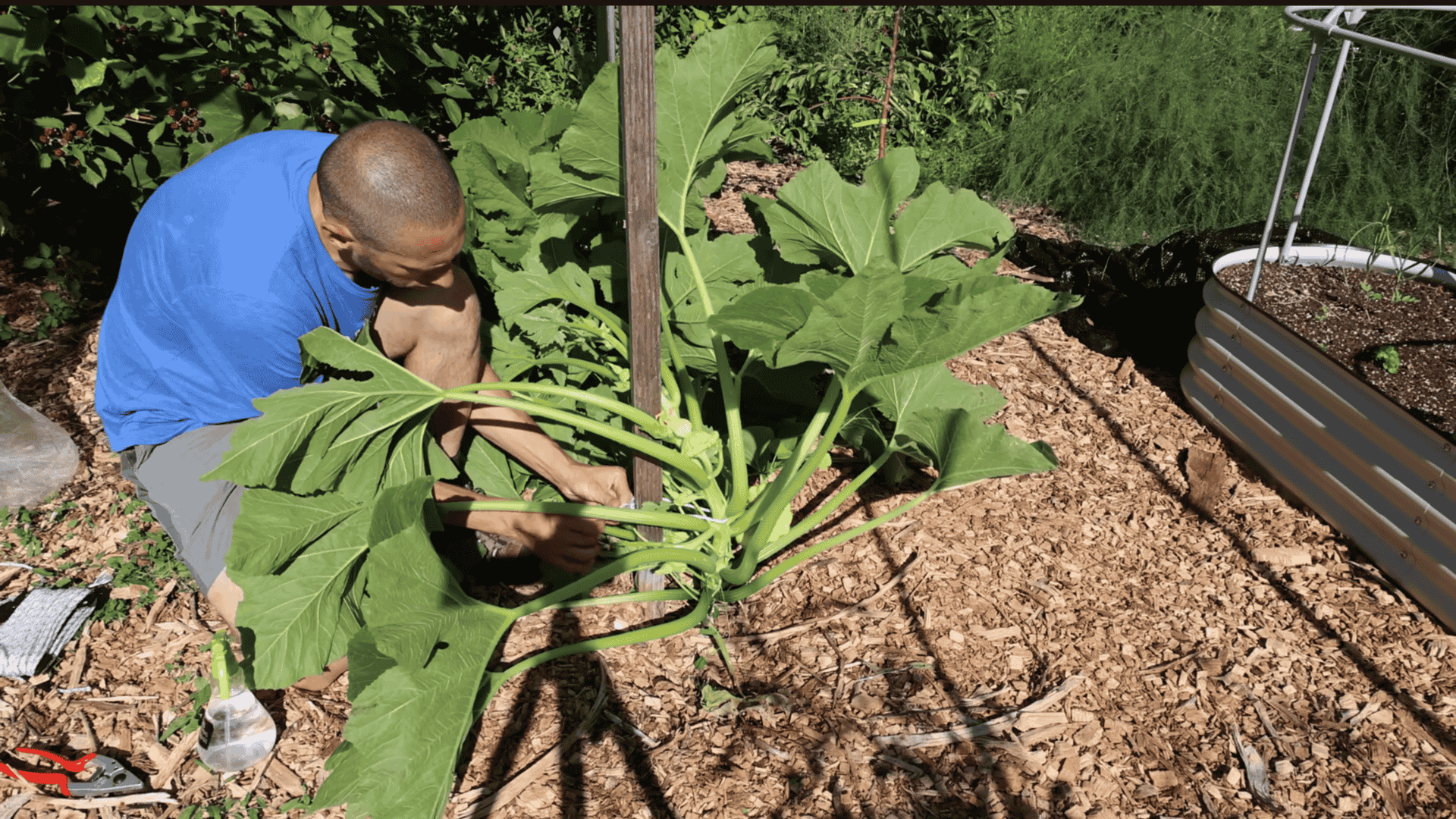
As vines begin to lengthen, gently guide them up the stake or trellis. Use soft ties or paracord to attach the main stem in several spots. This spreads the plant’s weight evenly and prevents stem breakage when fruits start to form.
Continue tying every few days as the vine grows. Good airflow and sunlight between the leaves will help keep fungal diseases away.
Step 4: Encourage Consistent Fruit Production
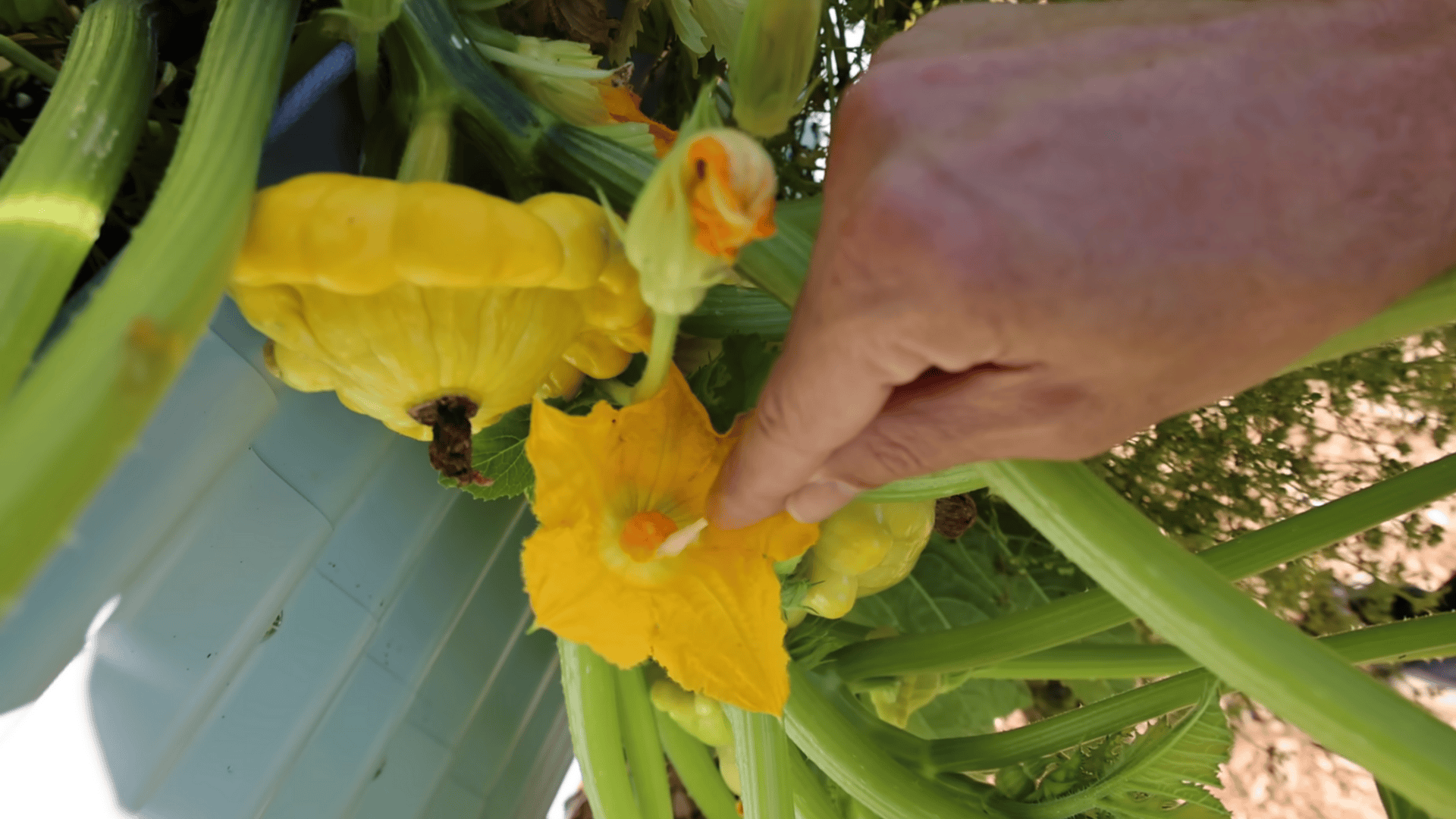
When flowers open, check for both male and female blooms. Hand-pollinate if bees are scarce by transferring pollen from a male flower (the one without a baby fruit) to a female flower (the one with a small squash at its base).
For summer squash, harvest frequently as soon as the flowers drop to encourage more blooms and steady fruiting.
For winter squash, allow fruits to fully mature on the vine before picking. This ensures proper ripening and longer storage life.
Step 5: Maintain Healthy Growth All Season

Inspect your plants regularly. Remove any yellow, damaged, or diseased leaves, especially near the base, to keep pests and rot from spreading. Clean your pruners with rubbing alcohol before cutting.
If vines get too tall, pinch off the main growing tip to promote productive side shoots. Should a vine crack, don’t worry; side shoots often take over naturally.
To extend your harvest, start new seedlings every few weeks so replacements are ready if older vines decline.
For More Detailed Instructions, Refer to The YouTube Video Below:
Choosing the Best Supports for Growing Squash Vertically
The right support structure makes or breaks vertical squash growing. Different systems work for different varieties, garden sizes, and budgets. Here’s a quick comparison to help gardeners choose the best option.
| Support Type | Best For | Height | Cost |
|---|---|---|---|
| A-Frame Trellis | Heavy squash, like butternut | 6-8 feet | Medium |
| Cattle Panel Arch | Multiple vining varieties | 7-8 feet | Low-Medium |
| Wire Cage | Compact varieties, containers | 4-6 feet | Low |
| String Trellis | Lightweight summer squash | 6-10 feet | Very Low |
| Wooden Ladder Frame | Small spaces, decorative gardens | 5-7 feet | Medium-High |
Common Problems and Solutions
Even well-planned vertical squash gardens face occasional challenges. Recognizing issues early and knowing quick fixes keeps plants productive all season.
These common problems have straightforward solutions that work.
- Vines Breaking from Supports: Happens when ties are too tight or plants grow too fast. Use soft fabric strips instead of wire, and check ties weekly to adjust as stems thicken
- Powdery Mildew on Leaves: Results from poor air circulation despite vertical growing. Remove lower leaves, space plants 3-4 feet apart, and apply neem oil at the first white spots
- Heavy Fruits Pulling Down Structures: Occurs with winter squash on lightweight trellises. Install fruit hammocks made from old t-shirts or mesh bags to cradle each squash individually
- Uneven Ripening or Sunscald: Caused by too much direct sun exposure on hanging fruits. Drape shade cloth over the south-facing sides during peak afternoon summer heat
Wrapping It Up
Vertical squash growing changes cramped gardens into productive spaces. Training vines upward delivers cleaner fruits, healthier plants, and easier harvests than traditional ground methods.
Success comes down to choosing appropriate squash types, providing strong trellises, and maintaining plants throughout the season.
Ready to reclaim garden space? Start small with one trellis and a few zucchini plants. Master how to grow squash vertically this season, then expand next year. The results will speak for themselves at harvest time.






